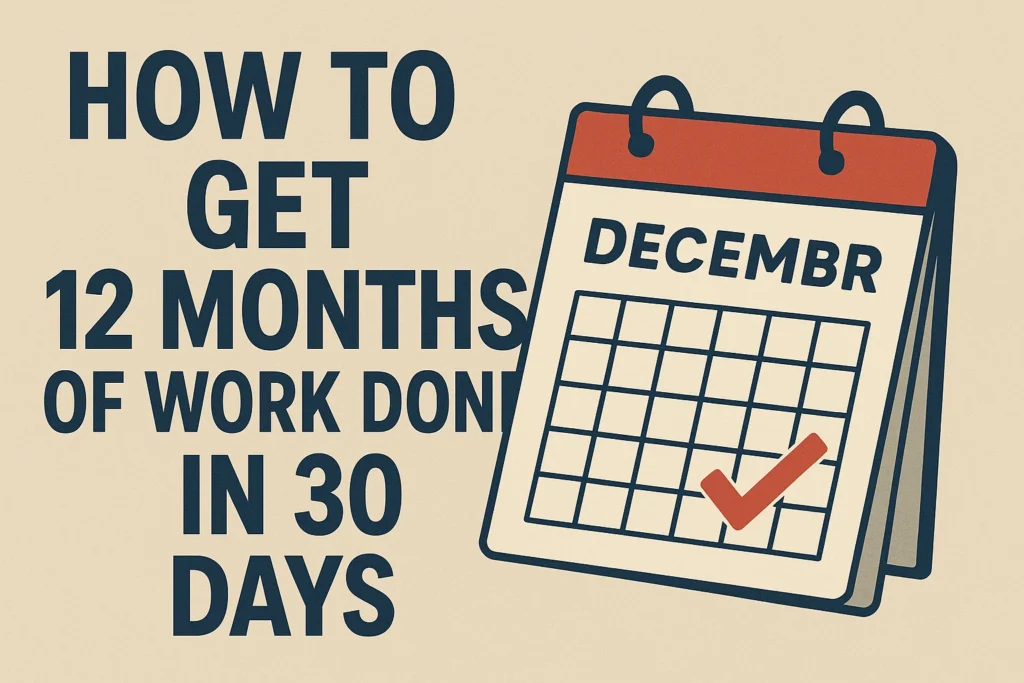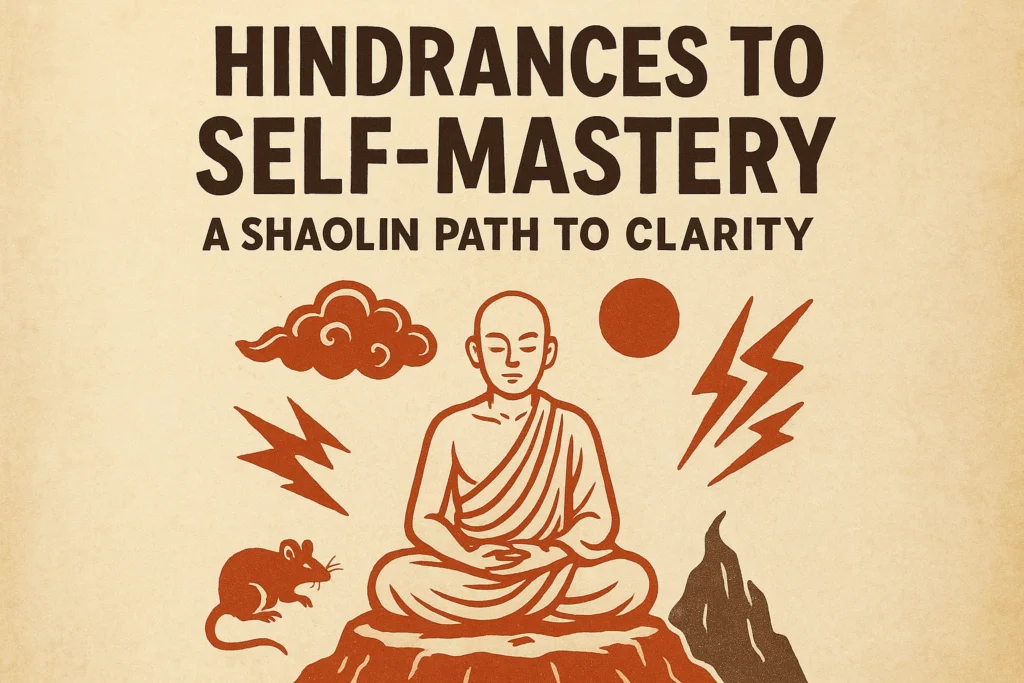Table of Contents
ToggleHow To Get 12 Months of Work Done In 30 Days

The Displacement Strategy for Accelerated Achievement
This briefing document summarizes the core principles and actionable framework of the "Displacement Strategy," - "How To Get 12 Months of Work Done In 30 Days." This strategy aims to help individuals achieve significant progress in a shorter timeframe by focusing on actual results rather than mere effort or time spent.
I. Core Concept: Displacement vs. Distance
The central theme revolves around distinguishing between "distance" and "displacement" in the context of achieving goals, particularly in learning.
Distance Strategy (Common but Inefficient):
This approach measures progress based on the amount of effort expended or time invested. Examples include:
- Amount of content covered.
- Number of notes written.
- Number of practice questions completed.
- Hours spent studying (e.g., the "1,000-hour rule").
The source explicitly states:
"These are actually all very useless measures of progress because what you get done during that time completely depends on your methods and your processes and all these other strategies."
The speaker's personal experience of studying "15 20 hours a day" for medical school, feeling "extremely burnt out constantly stressed constantly anxious working as much as possible and being the busiest I've ever been but somehow despite that feeling the least in control of what the result was going to be," exemplifies the pitfalls of this approach.
Displacement Strategy (Less Common but Highly Effective):
This approach focuses on actual progress towards the goal and the depth of understanding or mastery achieved. It measures "where they ended up compared to where they started."
- Measures of displacement are "a lot more specific to the goal."
- Key displacement metrics for learning include:
- Retention: How well information is retained.
- Mastery: "How deep your understanding is how complex of a problem can you solve using what you've learned."
- Achieving displacement requires active self-testing:
"when it comes to learning you actually have to test yourself to figure this out You have to actually test your retention and how deep your understanding is to see where the gaps are and how close you are to your goal."
The core idea is to:
"have the maximum possible displacement with the minimum possible distance Aka you want to make the most amount of progress with the least amount of work and time."
The ultimate purpose of distance-based activities (studying content, writing notes, practice questions) is to achieve retention and mastery. If these activities aren't leading to displacement, they are inefficient.
---II. The Four-Step Framework for Maximizing Displacement
The speaker presents a four-step framework, refined over 11 years, to achieve significant "displacement" in a condensed timeframe.
Step 1: Make the Win Criteria Very Clear
- Define your goal explicitly and break it down. Don't just state a vague target (e.g., "90% for this exam").
- Identify specific components for success: "What topics and what concepts covered at what level of depth? What are the things that you can get away with just trying to memorize? And what are the things that you need to use in a more complex way?"
- Enable continuous feedback: The goal is to "test yourself on your progress every week or every two weeks to see where the gaps are and actually make targeted changes to your strategy."
- Proactive understanding: The speaker's example of reading "all of the learning objectives all of the lecture objectives all of the assessment criteria all the marking rubrics" before starting, demonstrates the importance of knowing "what it would take to succeed."
Step 2: Scout the Type of Challenges
- Proactive identification of obstacles: Instead of reacting to problems after they occur, identify potential challenges beforehand. The speaker notes past mistakes of being "very reactive to any problems or issues."
- Two main types of challenges to scout for:
Content Type Challenges:
- Deliberately seek out "concepts that you're less familiar with the topics or the concepts that you feel like you're going to struggle with the most."
- Knowing these allows for allocating more time, more intensive study, more frequent self-checks, and potentially different learning strategies for these specific areas.
Timing Challenges:
- "Actually looking at your personal schedule and actually trying to figure out how you're going to manage on a daily basis to overcome your content challenges."
- Proper planning prevents reactive micromanagement, wasted time, stress, anxiety, and destabilization.
- The speaker shifted from generic "time blocks" to a "very targeted" approach for their masters, dedicating more time to areas of less confidence and higher density, tailored to specific challenges and restrictions.
Step 3: Plot Your Landmarks
- Define "displacement milestones" or checkpoints of progress. These are not just external deadlines (like exams).
- Create internal, proactive check-ins: Instead of just knowing an exam is 6 weeks away, plot points "where you can test yourself where you can check your knowledge anytime the challenges are changing moving from one topic to another topic."
- Self-imposed accountability: These landmarks are not "because anyone else requires it of you" but because "by testing yourself and getting that feedback data you are in a position where you can make faster changes and progress towards your goal more quickly."
- Examples include creating a personal testing schedule, starting assignments weeks early, or proactively meeting with lecturers to present learned models for early feedback.
Step 4: Create the Strategy
- Develop a plan to overcome challenges and hit landmarks to achieve win criteria efficiently.
- Shift focus from "how do I study more" to "how can I make sure that every hour I spend on trying to progress towards my goal is actually creating displacement and not just distance."
- Tailor the strategy: The specific strategy will "depend on your goal and depends on your challenges."
- Challenge assumptions and traditions: Be willing to "start from a blank slate" and eliminate conventional study methods if they don't serve displacement. The speaker's example of studying an entire paper in the first week, despite it being unconventional, was effective because it aligned with their clear win criteria, scouted challenges, and plotted landmarks.
- The contrast is drawn with classmates who relied on "do well" as their win criteria, "write more notes spend more time studying" as their mechanism, and reacted to challenges, thus being "forced onto a distance strategy."
III. Broader Applicability
The speaker emphasizes that the "Displacement Strategy" is a universal principle applicable beyond academic learning, including "business strategy" and "YouTube," for:
"Any situation where you want to make more progress towards your goals in a shorter period of time than it would normally take you."
---IV. Key Takeaway
The fundamental shift proposed is from measuring effort (distance) to measuring results (displacement). By proactively defining success, identifying obstacles, creating internal checkpoints, and strategically designing an approach focused on tangible progress, individuals can dramatically accelerate their achievement of goals. The human brain is capable of fixing problems it can see; the key is ensuring it's looking at the right indicators of progress.
The Displacement Strategy: Frequently Asked Questions
What is the core difference between the "distance strategy" and the "displacement strategy" for achieving goals?
The core difference lies in how progress is measured and pursued. The "distance strategy" focuses on the amount of effort or time spent (e.g., hours studied, pages read, notes written). It's about covering ground. In contrast, the "displacement strategy" focuses on actual progress towards the goal, emphasizing the impact of your actions and the depth of understanding or mastery achieved. It prioritizes efficient movement from your starting point to your desired outcome, making the most progress with the least amount of work and time.
Why is focusing solely on "distance" an ineffective approach to learning and achieving goals?
Focusing solely on "distance" (like hours studied or content covered) is ineffective because these metrics don't guarantee actual progress or understanding. As the source explains, someone could take 10,000 steps (distance) but end up back where they started (zero displacement). Similarly, spending many hours studying or writing extensive notes doesn't automatically mean you're retaining information or mastering concepts. This approach often leads to burnout, stress, and a feeling of lack of control, as the effort doesn't necessarily translate into desired results.
What are examples of "displacement" measures in the context of learning?
In the context of learning, "displacement" is measured by actual markers of understanding and mastery. Examples include retention (how well you remember and recall information), depth of understanding (how profoundly you grasp a concept), and the ability to solve complex problems using what you've learned. These measures require active testing and self-assessment to identify gaps in knowledge and make targeted improvements.
What are the four key steps of the displacement strategy framework?
The four key steps of the displacement strategy framework are:
- Make the win criteria very clear: Define your goal precisely, breaking it down into specific achievements and understanding what it truly takes to succeed (e.g., exact topics, required depth, types of application).
- Scout the type of challenges: Proactively identify potential obstacles, both "content challenges" (difficult concepts, areas of weakness) and "timing challenges" (how to manage your schedule to address content effectively).
- Plot your landmarks: Establish proactive, self-imposed "displacement milestones" or checkpoints along your path. These are opportunities to test your knowledge and understanding before external deadlines, providing frequent feedback on your progress.
- Create the strategy: Develop a tailored plan to overcome identified challenges and hit your landmarks, ultimately achieving your win criteria as quickly and efficiently as possible. This involves eliminating traditional assumptions about how work or study should be done and building a strategy from a blank slate.
How does "making the win criteria very clear" contribute to the displacement strategy?
Making the win criteria very clear is the foundational step because it defines the target for your displacement. Instead of vague goals like "getting a good grade," it requires breaking down what a "good grade" actually entails (e.g., specific topics, depth of understanding, types of problems to solve). This clarity allows you to establish concrete, testable markers of success, enabling continuous self-assessment and targeted adjustments to your strategy, rather than waiting for final feedback.
Why is it important to "scout the type of challenges" proactively, rather than reactively?
Scouting challenges proactively is crucial for the displacement strategy because it prevents wasted effort and stress from reactive problem-solving. By anticipating content (e.g., difficult topics) and timing (e.g., scheduling conflicts) challenges, you can allocate resources, plan your approach, and adapt your strategies before issues arise. This proactive stance ensures that your efforts are consistently directed towards meaningful progress, rather than being spent on last-minute firefighting.
What is the purpose of "plotting landmarks" in the displacement strategy?
Plotting landmarks serves as a system of "displacement milestones" that allow for continuous, internal assessment of progress. Unlike relying solely on external deadlines (like exams), landmarks are self-created checkpoints where you proactively test your understanding and gather feedback. This enables you to identify knowledge gaps early, make strategic adjustments on a weekly or bi-weekly basis, and accelerate your progress towards the ultimate goal by ensuring you're constantly moving with displacement.
How does the "create the strategy" step differ from traditional approaches to planning?
The "create the strategy" step differs significantly from traditional planning by emphasizing a blank-slate approach. Instead of simply trying to "study more" or following conventional methods, it requires you to actively design a strategy that maximizes displacement. This means questioning assumptions, eliminating ineffective practices, and tailoring your approach specifically to your unique goals, challenges, and landmarks. The focus shifts from merely putting in time to ensuring every minute contributes directly to actual progress and mastery.
Posts Gallery

Agentic AI for Enterprise Automation
Discover how Agentic AI revolutionizes enterprise automation, boosting efficiency and strategic decision-making.
Read More →
How Agentic AI Works: Intent to Execution
Unpack the intricate process of Agentic AI, from understanding user intent to executing complex tasks autonomously.
Read More →
Purpose & Use Cases of Agentic AI
Explore the diverse applications and strategic importance of Agentic AI across various industries and daily operations.
Read More →
What is Agentic AI?
A foundational article explaining the core concepts of Agentic AI, defining its components and its role in modern automation.
Read More →
Why Agentic AI?
Understand the compelling reasons and significant benefits that make Agentic AI a transformative technology for efficiency and innovation.
Read More →
AI Tools Spotlight
A comprehensive overview of cutting-edge AI tools that are shaping the future of automation and intelligent systems.
Read More →

